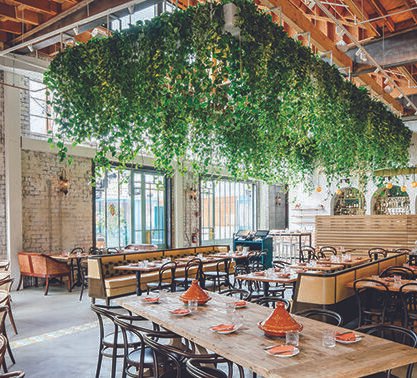Exposed Ceiling is used in modern homes, industries, cafeterias, and restaurants to give a raw yet lavish look. They help in justifying the exposed beams on the roof, without being a hindrance to the aesthetic look for the overall look. The concept emerged from plastered roofs to false ceiling, slowly, moving towards the exposed ceiling to enhance the way users experience the space.
Types of exposed ceilings are :

PVC and Truss Ceiling:
These provide an industrial look to the cafeteria and public spaces. They have been in fashion for a few years ago. They’ve helped in decreasing the cost while the maintenance is also easy.

Beamed Wooden Ceiling:
These ceilings are an escape to find the aesthetic sense for the heavy structures which are obligated to surface the depth of the beam, which may pass through the centre of the room. They are made of the RCC and cement concrete giving a brutalist look to the interior space. They may be complemented with the metal artefacts, wooden furniture and can add up to make a cosy space.

Exposed Box ceiling:
This kind of exposed roof in generally used in luxurious spaces, as it looks like velvet which the exposing material as cement, painted in any dark colour that attends to the attention of the user in which the furniture and walls are of light colours thus complementing the roof.

Mesh Ceiling:
The mesh style exposed roof, categorized to be in co-working spaces, high rise buildings, and open floor plan offices. They create an impregnable, and hefty look. These are all used to create a look that defines a sturdy space and captivates the ambience in a very similar way.

Upside Down Ceiling(Staggered):
The upside-down garden is the most refreshing, and fresh look to be accommodated in the interior spaces. They have been in trend for large spaces, reception halls, etc. It is an expensive ceiling style, it is also difficult to maintain, hence, us not used that commonly.

Upside-down ceiling:
This is similar to the previous one. It has different construction techniques and specifies a different organizational pattern for the space in which it is constructed or designed. It creates an ambiance of the internal greenery in the cafeteria spaces, etc.

Wooden Ceiling:
The wooden exposed ceiling is a taste for the high budget. It is an expensive ceiling with high maintenance. The client needs to be careful about the drawbacks of the kind of wood that is being used.

PVC-Truss Ceiling:
These ceilings are generally used in spaces where there are no floors over the head, they can be used in areas that have to be given an industrial look altogether. It is used in gyms, receptions, etc. They go well with the truss-style as well as the aluminum shed overhead. The maintenance is also easier than other exposed ceiling forms.

Inclined Truss Ceiling:
These ceilings can be found in workshops for artisans, nurseries, and industries when the sloped roof is necessary as well as it gives the feeling of grandeur. The skylight/ sloped windows or openings could be an easier thing that could be given to the places that need the excessive portion to be that way.

Inclined Wooden and Truss ceiling:
These kinds of roofs are given where there is a possibility of mezzanine floors. They provide a vintage look and user experience to the place, hence have been used customarily throughout. It had gained high popularity in the 1990s but it depends on the weather of the place as well.

Exposed Duct Ceiling:
This kind of roof is used where the clients/designers demand a different way of centralized air conditioning unit. It is a duct based Air conditioner which is used in many spaces, where there is a probability of higher footfall, frequently. They need to be maintained properly due to the air conditioning ducts and it needs to be cleaned often.
There is an increasing demand of luxurious spaces and thus there is an increase of such spaces where even with the ceiling, designers are trying to play with the volumes, voids, materials, and are in a quest to improve the user experience.


